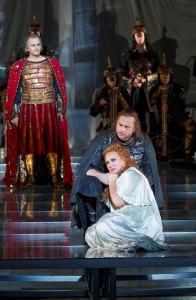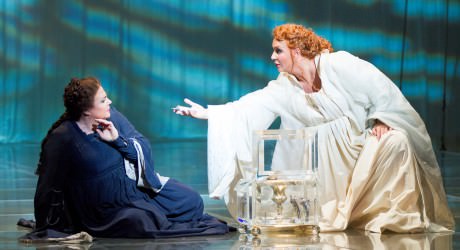Washington National Opera opens the season with a transformative production of Richard Wagner’s epic tragedy Tristan and Isolde for his bicentennial birthday. He wrote both the music and the libretto. It may be epic in scope and score, clocking in at almost five hours, but this is a simple story of impossible love. WNO Artistic Director Francesca Zambello is committed to showcasing Wagner leading up to the WNO’s first complete production of his Ring cycle in 2016.

Director Neil Armfeld, who first created this production with Opera Australia, has stripped this story to its essentials. Often there are only two voices on a stage bare of any furniture or prop and he keeps the action streamlined as well, the better to highlight the decidedly not simple score and vocals. Wagner had trouble finding a theater to put it on, and due to the unusual score and the ridiculously challenging main parts. Its reputation has only been enhanced by the fact that two different conductors have died after collapsing during Act 2. WNO Music Director and conductor Phillippe Anguin with the WNO orchestra is undaunted. The opera begins soft and slow with the infamous “Tristan chord” of the “Prelude,” infamous for its dissonance. Unlike most songs of then…and now for that matter…that usually resolve each phrase, Wagner held off finishing this first phrase of music until the final act hours later. It makes for a haunting, strangely tense piece, a perfect fit for the themes of longing and perfection he explores in the libretto. It was way ahead of its time, which is perhaps why it feels so familiar. Much of modern cinematic composition owes a debt to this opera. From that dreamy opening to the triumphant entrance of the king to the powerful final act, Anguin has a firm hand on the baton.
The set by Opera Australia and costumes by Jennie Tate are not necessarily modern or historical, but look as if they were pulled from a dream. Billowing white fabric drapes the backdrop and real water covers the stage. The fabric becomes a screen at points to cleverly silhouette the offstage action. A huge, tilted platform of glass and steel suspended from the ceiling conjures the ghost of a ship. The costumes of the court are historical armor of a lost land, full of gilt. In contrast, Isolde is draped in billowing folds of white that seemed a bit unwieldy and Tristan in steel-grey.
Swedish soprano Iréne Theorin (Isolde) joined the production only a week ago when Deborah Voigt had to withdraw. Like the score, this character is way ahead of her time. Isolde is a smart, powerful woman. Theorin has a truly beautiful voice for this almost impossible role. She closes the opera with the iconic and transcendent “Mild und leise wie er lachelt” (How softly and gently he smiles), better known as “Isolde’s Liebestod.” (Alwyn Mellor will play Isolde on September 27th).
British tenor Ian Storey (Tristan) has a resonant tenor and powerful stage presence. His smooth voice is particularly well suited to the love longs. His final aria “Oh diese Sonne! Ha, dieser Tag!” (Oh this Sun, Ah this Day!) combined everything that is wonderful about opera – serious drama and glorious singing. (Clifton Forbis will play Tristan on September 27th).
It’s difficult to believe these two worked together for less than a week on this production. Their chemistry is electric. The plot hinges on a love potion, but the two manage to make the abrupt switch between love and hate realistic. Act two is one long duet between them as they debate the nature of love and enjoy each other. Their first meeting is chilling in “Isolde! Gelibte! Tristan! Gelibeter!” (Isolde! Beloved! Tristan! Beloved!)
Mezzo-soprano Elizabeth Bishop (Brangäne) has a wonderful way with the German language, and a voice powerful enough to hold her own in duet with Theorin. They both sound amazing on “Weh, ach Wehe! Dies zu dulden” (“Alas! Ah! The Evil that I foresaw”) and “Mir Erkoren, Mir Verloren” (Chosen for me, Lost to me). Bass-baritone James Rutherford (Kurwenal) has the liveliest motifs in his role as Tristan’s servant on arias like the moving, “Hei nun! Wie du kamst!” (Indeed, How did you get here?). King Marke (Wilhelm Schwinghammer) is built up for half the opera before his entrance and he does not disappoint. Like the other characters, he is not a typical monarch and his heartfelt aria about his broken heart is one of the highlights, “Tatest du wirklich?” (Have you indeed?)
Two performers Yuri Gorodetski and Norman Garrett are members of the Domingo-Cafritz Young Artist Program. Gorodetski (Young Sailor) opens the opera singing offstage “Westwarts Sweift der Blick” (Westwards the Gaze Wanders) about an Irish maid. Javier Arrey, a graduate of the program, plays Melot with verve and power that shows his training has paid off. He clearly delights in his role as the villain.
Known best for his special effects and special instruments, Wagner eschewed fireworks in favor of intellectual challenge. He drew deeply from philosopher Schopenhauer and his ideas of a perfect unseen world and decidedly imperfect present. Tristan and Isolde fall in love in act one, spend act two both cursing and musing on the imperfect day and the true world of night, before the obligations of the day overtake them in act three. Lighting Designer Toby Sewell did the heavy mood lifting between that all-important day and night, though the best moments were the transitions in gorgeous sunsets and sunrises as he drenched the stark set in orange and red.

For the orchestration, Wagner stuck with the usual instruments of the time with one exception. When Tristan imagines his love arriving, Wagner couldn’t quite find the sound he wanted so he invented a “holtztrompete” or a trumpet made of wood, known now as the Tristan Trumpet. The WNO is using one in this production for the first time.
This is an intimate production of a sophisticated opera, far ahead of its time in musicality, philosophy, and character – tackling death, glory and the transformation of music as we know it with its beautiful motifs and singing parts and a polished, intellectually challenging libretto. Aside from the staging, it is simply beautiful from the first famous chord to the final Liebestod. Washington National Opera has created a wondrous, soul-filling production.
Running time: Four hours and 45 minutes, with two 25-minute intermissions.
Tristan and Isolde plays through September 27, 2013 at Washington National Opera at The Kennedy Center’s Opera House – 2700 F St. NW, in Washington, DC. For tickets, call the box office at (202) 467- 4600, or purchase them online.





I very rarely attend long, dramatic Wagner operas. They simply do not appeal to me. An opportunity came up to try this one. Try we did…like we did not!
It was fabulous! I too have a hard time with long operas and I thought Wagner, but oh my the first act alone is worth it. Brava to Theorin and Bishop!
Jessica, your review was simply splendid. You caught all the high points and highlighted what to look for. As high entertainment, this opera is not for beginners. Love, loss, and dramatic dissonances permeate this opera deeply and talk to the human core on a level difficult to fathom unless you are exceedingly musical or exceedingly brave of heart. In all honesty, I could hardly stay awake for the whole performance on Sunday, the 15th of September, as I drifted lightly in and out of the state I call my “Wagnerian trance”. It isn’t about really understanding the opera in your left brain, a.k.a. rationally — it is all about feeling the depths of your heart and finding yourself deeply in the music of a giant mind like Wagner. Say what you will, for a beginner like me, this can be tedious and curiously uninspiring on a personal level, and yes! a very expensive outlay of cash for tickets, transportation (from Baltimore for me), food, and miscellaneous extras. But it is also a pinnacle of human creativity that is definitely worth touching — for me at least once. I am glad I went!